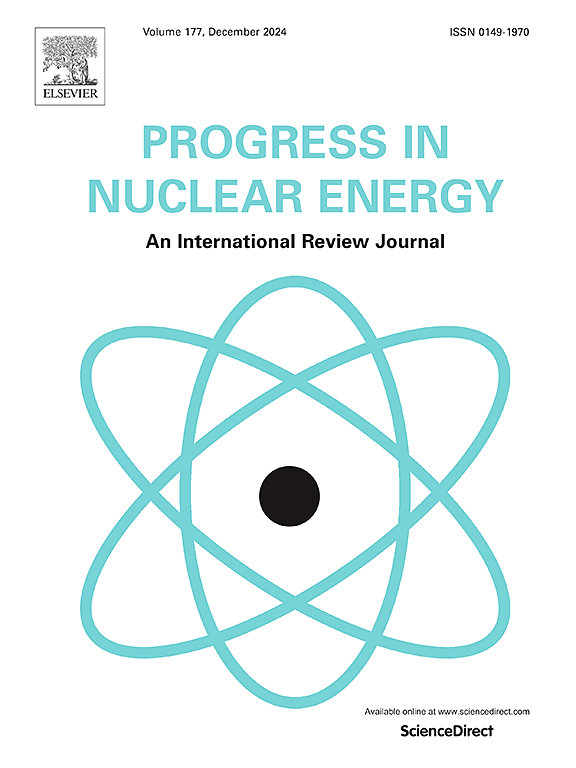Numerical simulation and experimental validation of DLOFC transients in a high temperature helium loop embedded with AM geometry
IF 3.2
3区 工程技术
Q1 NUCLEAR SCIENCE & TECHNOLOGY
引用次数: 0
Abstract
The Transformational Challenge Reactor (TCR) draws inspiration from High-Temperature Gas-Cooled Reactors (HTGRs) and leverages the advantages of additive manufacturing technology, particularly by incorporating additively manufactured fuel elements. Similar to HTGRs, the TCR incorporates engineered passive safety features designed to effectively remove heat during a Loss of Forced Cooling (LOFC) event. A Depressurized Loss of Forced Cooling (DLOFC) accident is a design basis accident in the TCR, occurring when a breach in the coolant system leads to depressurization. This allows air to enter the core or plenum through mechanisms such as diffusion, gravity currents, or natural circulation. After several hours following the depressurization, the Onset of Natural Circulation (ONC) may occur, driving bulk air ingress into the core. This paper presents a numerical study aimed at investigating the underlying physics and predicting the influence of Additively Manufactured (AM) geometry during air ingress transients. These simulations were performed for two different geometric configurations: one without the AM part, referred to as the base geometry, and the other with the AM part. The test geometry and boundary conditions used in the analysis were obtained from the experiment. Transient fluid temperature profiles and helium concentration distributions were obtained. A thorough comparison between the predicted ONC times and temperatures with the experimental data was conducted. The model results were found to be in good agreement with the temperature distribution and ONC times reported in the experiment.
嵌入AM几何结构的高温氦回路中DLOFC瞬态的数值模拟与实验验证
转型挑战堆(TCR)从高温气冷堆(htgr)中汲取灵感,利用增材制造技术的优势,特别是通过加入增材制造的燃料元件。与htgr类似,TCR采用了被动安全设计,可在强制冷却损失(LOFC)事件中有效散热。减压强制冷却损失(DLOFC)事故是TCR的设计基础事故,发生在冷却剂系统破裂导致降压的情况下。这允许空气通过扩散、重力流或自然循环等机制进入核心或静压室。减压几个小时后,可能会发生自然循环(ONC),导致大量空气进入堆芯。本文提出了一项数值研究,旨在探讨潜在的物理和预测增材制造(AM)几何形状对空气入口瞬变的影响。这些模拟是针对两种不同的几何结构进行的:一种没有AM部分,称为基本几何结构,另一种有AM部分。分析中使用的试验几何形状和边界条件由实验得到。得到了瞬态流体温度分布和氦浓度分布。预测的ONC时间和温度与实验数据进行了彻底的比较。模型结果与实验报告的温度分布和ONC次数吻合较好。
本文章由计算机程序翻译,如有差异,请以英文原文为准。
求助全文
约1分钟内获得全文
求助全文
来源期刊

Progress in Nuclear Energy
工程技术-核科学技术
CiteScore
5.30
自引率
14.80%
发文量
331
审稿时长
3.5 months
期刊介绍:
Progress in Nuclear Energy is an international review journal covering all aspects of nuclear science and engineering. In keeping with the maturity of nuclear power, articles on safety, siting and environmental problems are encouraged, as are those associated with economics and fuel management. However, basic physics and engineering will remain an important aspect of the editorial policy. Articles published are either of a review nature or present new material in more depth. They are aimed at researchers and technically-oriented managers working in the nuclear energy field.
Please note the following:
1) PNE seeks high quality research papers which are medium to long in length. Short research papers should be submitted to the journal Annals in Nuclear Energy.
2) PNE reserves the right to reject papers which are based solely on routine application of computer codes used to produce reactor designs or explain existing reactor phenomena. Such papers, although worthy, are best left as laboratory reports whereas Progress in Nuclear Energy seeks papers of originality, which are archival in nature, in the fields of mathematical and experimental nuclear technology, including fission, fusion (blanket physics, radiation damage), safety, materials aspects, economics, etc.
3) Review papers, which may occasionally be invited, are particularly sought by the journal in these fields.
 求助内容:
求助内容: 应助结果提醒方式:
应助结果提醒方式:


